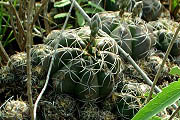Gymnos in habitat
Gymnocalycium fleischerianum (Meregalli, Metzing, Kiesling, Vala)
The first plants came to Berlin in 1895. Its discoverer was Prof. Hassler. From that time onward, Mr. Grosse - a collector from Paraguay - sent numerous plants to the company of Ferdinand Haage in Erfurt. Those specimen were described as varieties of Echinocactus denudatus in the magazin "Monatszeitschrift für Kakteenkunde" in 1898. These plants soon vanished from most collections. New imports were being sold as Echinocactus denudatus var. anisitsii by the company Haage, but these soon were to disappear from the collections as well. In the year of 1929, these cacti appeared in the catalog of A. V. Fric - this time named Gymnocalycium denudatum var. anisitsii. The Czech F. Jajo formulated a description he never published. C. Backeberg then issued the first description by Jajo, although lacking the at that time already obligatory latin diagnosis.
In 2002 G. fleischerianum was formally and validly described by M. Meregalli, D. Metzing and R. Kiesling (published in Candollea #57) and was classified as a form of G. paraguayense. The plants were revalidated as an independent species by L. Vala in the magazine Gymnocalycium.
G. fleischerianum is a very variable species. The ribs are even and barely humped. We always found the plants sitting at slabs of sandstone, often protected by small bushes and bolsters of grass and moss. Its system of roots is extremely flat and grows up to one meter in length. The spectrum ranges from long-thorned to almost bare cacti. The habitats are very territorially restricted. In my opinion, there is no genetic exchange between populations of different habitats. East-Paraguay is densely populated and its soil is heavily used for agriculture. Because of that, there remain only very few intact habitats, often confined to a few square metres.
